Unveil the mystery of celestial gateways in the Bible, where divine encounters blur the lines between heaven and earth.
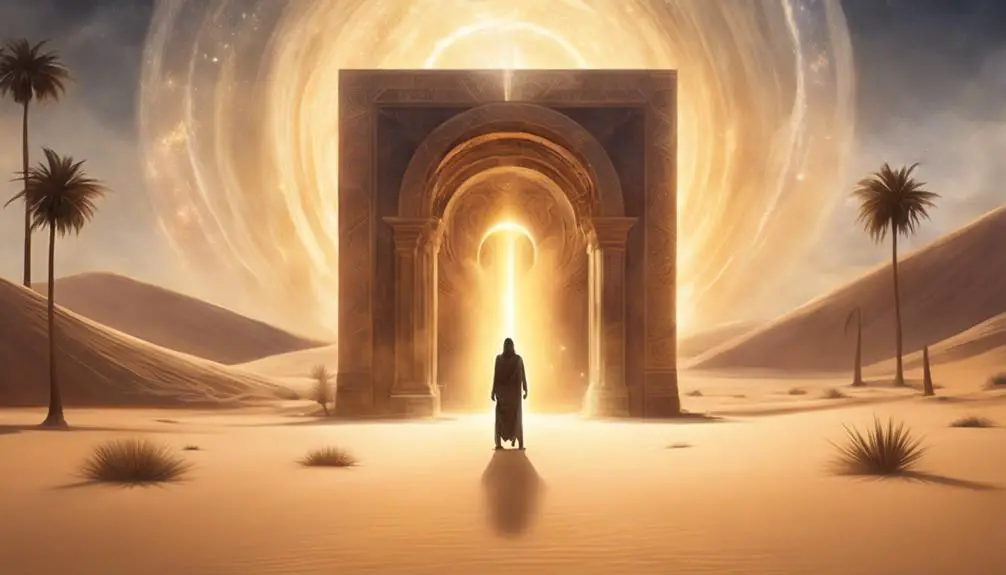
Portals in the Bible
Imagine scrolling through your timeline and stumbling across a surreal post: gateways in the Bible. You're likely familiar with stories like Jacob's dream of a ladder to heaven or Elijah's ascent in a fiery chariot, but have you ever considered them as more than just metaphors or visions?
These narratives can be seen as ancient texts' depiction of portals—thresholds between the divine and the earthly. Each story offers a unique lens through which to explore the intersection of the mundane and the miraculous. What might a closer examination of these passages reveal about the nature of these celestial gateways and their significance in the broader biblical context?
Let's begin this journey together, and you might just uncover something extraordinary.
Key Takeaways
- Biblical portals signify moments of profound divine-human interaction and spiritual elevation.
- Symbolism, such as Jacob's ladder and Revelation's imagery, invites exploration of divine mysteries.
- Portals often mark divine intervention, communication, and guidance, as seen in Moses' burning bush and Jesus' baptism.
- Revelation's symbols, like beasts and seals, depict complex divine judgments and end times narratives.
Jacob's Luminous Ladder

Jacob's Luminous Ladder, described in Genesis 28:10-19, serves as a pivotal biblical instance of a portal, symbolically bridging the divine and the earthly realms. This narrative isn't just a tale; it's a profound exploration of dream interpretation and angelic communication. You'll find that scholars often reference this passage when discussing the intersection of the human and divine, suggesting that dreams may serve as conduits for divine messages.
In your exploration of this topic, it's crucial to consider the ladder not merely as a physical structure but as a metaphorical pathway. The angels ascending and descending imply a two-way communication between God and humankind, highlighting the ladder's role as a bridge for this exchange. This aspect of angelic communication, as depicted in Jacob's dream, underscores the belief in the accessibility of divine guidance through dreams.
Furthermore, the interpretation of Jacob's dream has been a subject of scholarly debate, with many proposing that the ladder symbolizes the connectivity of all beings to the divine. This connectivity isn't just vertical, between the earthly and the divine, but also horizontal, encompassing angelic beings who mediate this relationship. Through this lens, Jacob's Luminous Ladder becomes a multi-dimensional portal, enriching our understanding of divine interaction in biblical narratives.
Moses and the Burning Bush
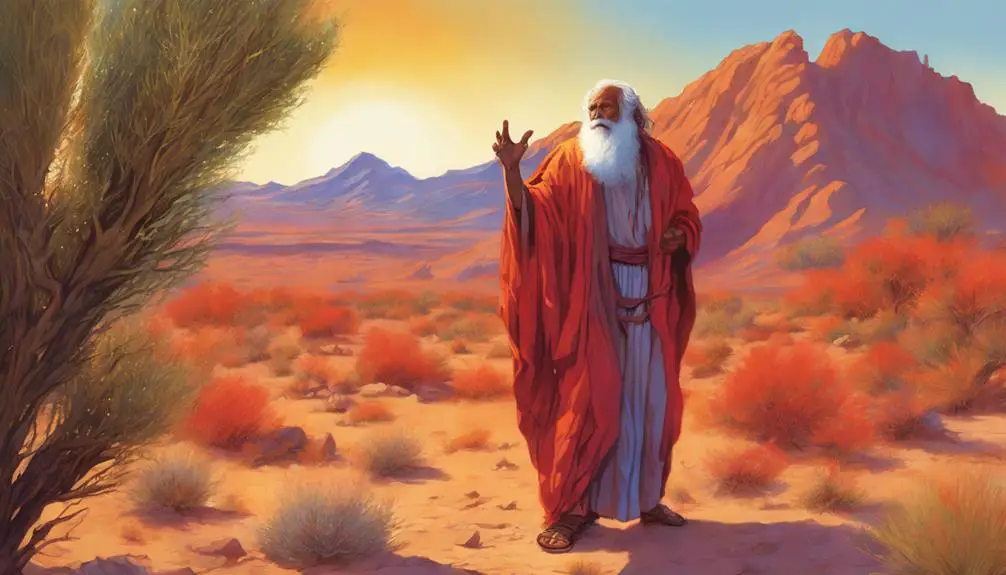
In the narrative of Moses and the Burning Bush, found in Exodus 3:1-17, we encounter another profound biblical instance where the divine communicates directly with humanity, establishing a sacred portal not through dreams, but within the tangible reality of the natural world. This event marks a pivotal moment in biblical history, illustrating the direct intervention and guidance of the divine in human affairs.
To paint a clearer picture of this encounter, consider the following elements:
- Location: Moses finds himself on Mount Horeb, also known as the mountain of God, a place already steeped in spiritual significance.
- The Bush: A seemingly ordinary bush burns without being consumed, catching Moses' attention and setting the stage for divine communication.
- Divine Voice: God speaks directly to Moses from the bush, identifying Himself and issuing a call to action.
- Holy Ground: The area around the bush is declared holy, emphasizing the sanctity of divine-human interaction.
This narrative underscores the themes of divine communication and holy ground, revealing the ways in which the divine chooses to reveal itself and interact with humanity in the physical realm.
Elijah's Fiery Chariot
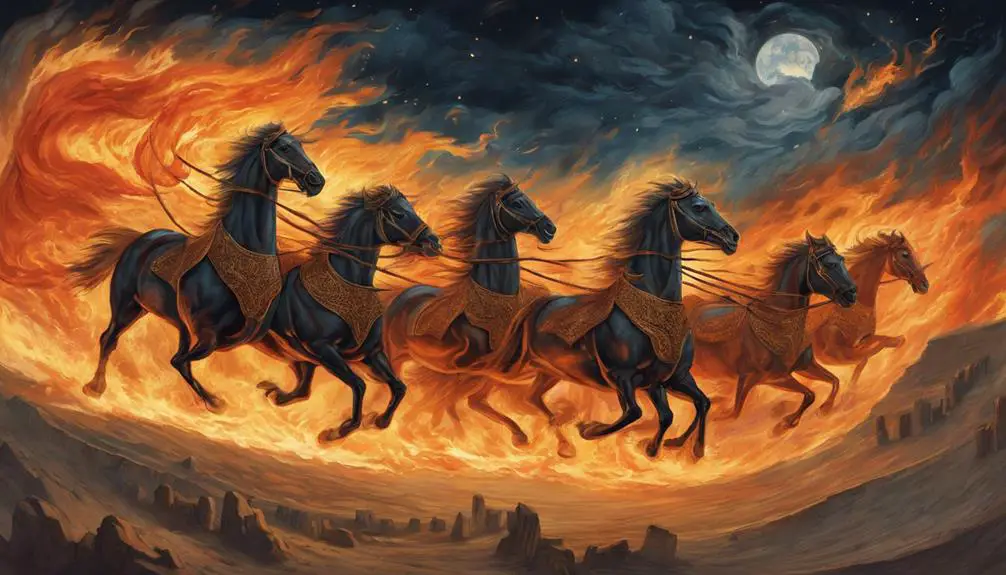
Transitioning from Moses' encounter with the divine, we now explore another pivotal moment in biblical narratives: Elijah's ascent to heaven in a fiery chariot. This event is not merely a dramatic departure but embodies profound chariot symbolism and prophet ascension, marking a direct interaction between the divine and the human realms.
Elijah's fiery chariot, as described in the scriptures, serves as a divine vehicle, transcending earthly boundaries. This ascension is symbolic of spiritual elevation and the ultimate union with the divine, highlighting the theme of prophet ascension in a way that complements the broader narrative of divine-human interaction.
Aspect |
Significance |
|---|---|
Chariot |
Symbolizes divine intervention and the passage between earthly and heavenly realms. |
Fire |
Represents purification, transformation, and the presence of God. |
Ascension |
Embodies the prophet's spiritual elevation and ultimate union with the divine. |
Prophet Elijah |
Serves as a model for divine engagement, illustrating the potential for human-divine connection. |
Analyzing Elijah's fiery chariot within this framework, we uncover layers of meaning that resonate with themes of divine guidance, transition, and the role of prophets as mediators between God and humanity.
Ezekiel's Visionary Wheels
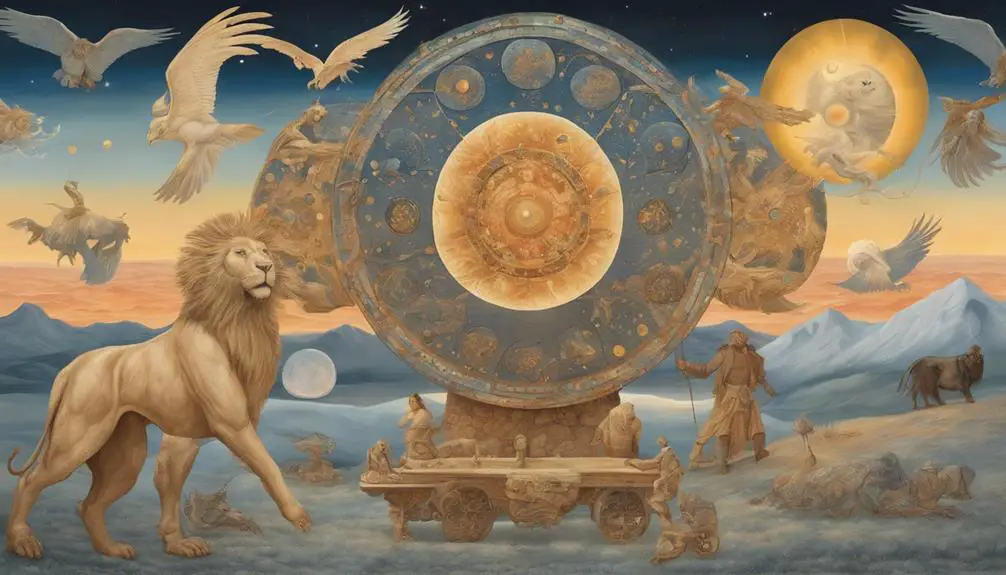
Continuing our exploration of divine-human interactions in biblical narratives, we now turn our attention to Ezekiel's visionary wheels, a complex symbol of divine presence and mobility. This passage, rich in mystical symbolism and sometimes cited in discussions of ancient ufology, offers a vivid depiction of the interaction between the divine and the earthly.
To paint a picture for the audience, consider these elements:
- The Appearance: The wheels are described as gleaming like beryl, a precious stone, embodying the brilliance and otherworldliness of the vision.
- The Construction: Each wheel is noted to be intersecting another, a design that signifies not just physical mobility but also the ability to traverse different dimensions or realms.
- The Movement: The wheels move in conjunction with living creatures, indicating that divine movement isn't random but purposeful and directed by a sentient will.
- The Sound: The noise of the wheels, likened to the roar of great waters, emphasizes the power and majesty of the vision, reinforcing the awe-inspiring presence of the divine.
This segment of Ezekiel's vision encapsulates not only the mystical symbolism inherent in biblical texts but also sparks curiosity within ancient ufology circles, highlighting the enduring fascination with these ancient narratives.
The Open Heavens at Jesus' Baptism

Jesus' baptism marks a pivotal moment in biblical narratives, where the heavens open, signifying a direct divine intervention and communication. This event, chronicled in the Gospels (Matthew 3:16, Mark 1:10, Luke 3:21-22, and John 1:32-34), serves as both divine endorsement and spiritual initiation for Jesus' public ministry. As you delve into the text, you'll notice the heavens' opening isn't merely symbolic but a literal manifestation of God's presence and approval.
The act of baptism itself, performed by John the Baptist in the River Jordan, is significant. Yet, it's the opening of the heavens and the descent of the Holy Spirit like a dove that marks a transformative moment. This divine occurrence signals the inauguration of a new covenant and the fulfillment of Old Testament prophecies. It's a clear declaration of Jesus' identity as the Son of God, endorsed by God's own voice from the opened heavens, 'This is my beloved Son, with whom I'm well pleased' (Matthew 3:17).
This narrative extends beyond its historical and religious context, inviting you to reflect on the nature of spiritual initiation and divine endorsement. Through this lens, Jesus' baptism isn't only a foundational Christian event but also a profound moment of intersection between heaven and earth, highlighting the pivotal role of open heavens in biblical revelation and spiritual transformation.
John's Apocalyptic Revelations
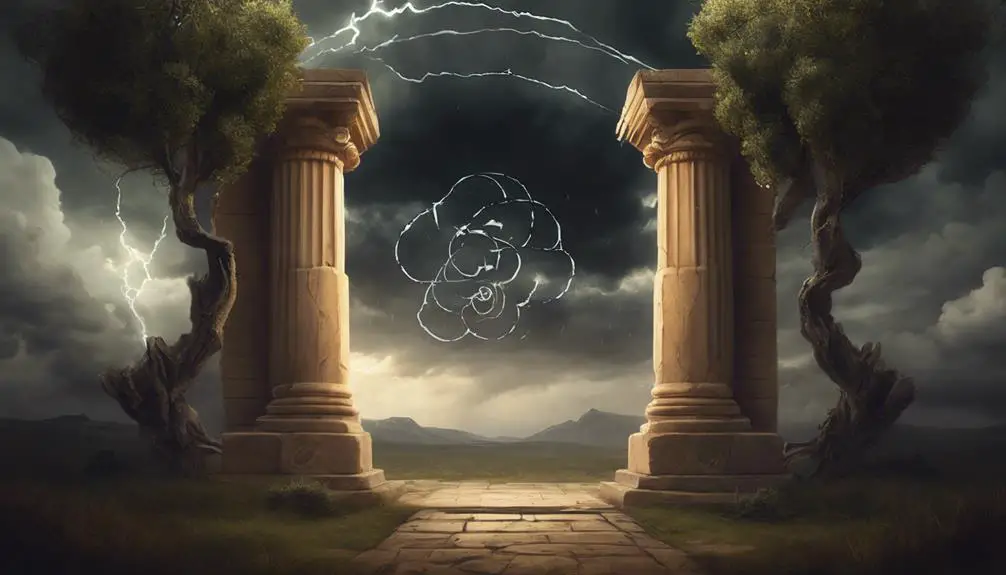
In the New Testament, the Apostle John's apocalyptic visions, as detailed in the Book of Revelation, offer a profound exploration of cosmic conflict and ultimate redemption. These visions are rich with symbolic imagery and numbers that carry deep significance, painting a vivid picture of the end times. Here's a closer look:
- Beast Symbolism: The beasts in Revelation represent empires and governments opposed to God's ways. Scholars often interpret the first beast from the sea as a symbol of imperial Rome, embodying political power and opposition to the divine (Rev. 13:1-2).
- Number Significance: Numbers in Revelation carry symbolic meanings. The number 666, associated with the second beast or the false prophet, symbolizes imperfection and contrasts with the divine number seven, which signifies completeness and perfection (Rev. 13:18).
- Seven Seals: The opening of the seven seals by the Lamb (Jesus Christ) reveals divine judgments. Each seal represents a different aspect of the end times, including conquest, war, famine, and death (Rev. 6:1-8).
- Four Horsemen: Symbolizing conquest, war, famine, and death, the four horsemen are agents of judgment that bring about the end times (Rev. 6:1-8). Their appearance serves as a warning and symbolizes the consequences of turning away from God.
Through these elements, you're invited to delve deeper into the mysteries of the divine narrative, understanding the intricate balance between judgment and redemption.
Frequently Asked Questions
How Have Interpretations of Biblical Portals Evolved in Modern Theology and Popular Culture?
You've seen how interpretations of biblical portals have shifted in modern theology and popular culture, influenced by angelic interpretations and cultural symbolism. Scholars argue these portals, once seen as divine gateways, now blend ancient texts with contemporary spiritual beliefs.
This evolution reflects a broader trend where religious symbols are reimagined within today's cultural narratives, integrating angelic lore and symbolism to connect past wisdom with present-day understanding.
Are There Any Archaeological Findings That Support the Existence of Portals or Similar Phenomena as Described in the Bible?
Diving into the heart of your curiosity, you're seeking tangible threads between myth and reality.
No archaeological discoveries have directly confirmed the existence of portals as you might imagine them. However, ancient inscriptions and mythological parallels offer a fascinating glimpse into how past civilizations conceptualized transitions between worlds.
Scholars analyze these findings, piecing together a tapestry that, while not proving, enriches our understanding of such phenomena in a historical and cultural context.
How Do Different Religious Traditions Outside of Christianity View and Interpret the Concept of Portals or Divine Gateways?
You'll find that religious traditions outside Christianity have their unique perspectives on portals or divine gateways. In Hindu cosmology, such gateways often appear as connections between the physical and the divine realms, facilitating both communication and travel.
Similarly, shamanic journeys, found in various indigenous cultures, involve traversing portals to access spiritual worlds for guidance or healing.
These concepts, while varying in details, underscore a universal intrigue with realms beyond our immediate perception.
Can the Concept of Portals in the Bible Be Related to Any Scientific Theories or Phenomena, Such as Wormholes or Dimensions in Physics?
You're diving into whether scientific theories, like wormholes or dimensions in physics, can relate to portals.
Specifically, concepts such as quantum entanglement and the multiverse hypothesis offer intriguing parallels. Quantum entanglement, bridging distances instantaneously, echoes the instantaneous nature of biblical portals.
Meanwhile, the multiverse hypothesis, suggesting numerous realities, aligns with the idea of multiple spiritual realms.
These connections provide a fascinating intersection of spirituality and science, warranting deeper exploration.
How Do Personal Experiences and Testimonies of the Supernatural in Contemporary Times Compare to Biblical Accounts of Portals and Divine Encounters?
Your experiences and testimonies of the supernatural today often mirror biblical accounts of divine encounters, yet they require spiritual discernment for validation. While the Bible's narratives provide miraculous validation of such phenomena, contemporary accounts vary in verifiability.
It's crucial to analyze these experiences critically, comparing them to historical texts to discern their authenticity. This analytical approach helps bridge the gap between ancient beliefs and modern-day supernatural experiences.
Conclusion
In conclusion, while contemporary interpretations might liken these biblical events to 'portals,' traditional exegesis views them as divine revelations or theophanies. Jacob's ladder, Moses' burning bush, Elijah's chariot, Ezekiel's wheels, the open heavens at Jesus' baptism, and John's apocalyptic visions each serve as unique encounters with the divine, rather than literal portals in a modern sense.
Scholars, such as Walton (2009) and Beale (2011), argue these narratives symbolize communication and interaction between the divine and the earthly realm, emphasizing God's immanence and transcendence.



Sign up